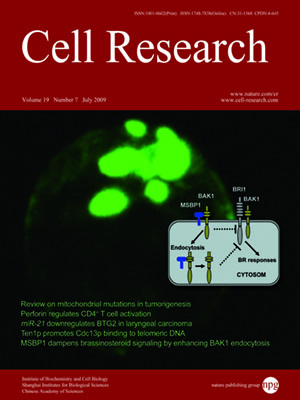
Volume 19, No 7, Jul 2009
ISSN: 1001-0602
EISSN: 1748-7838 2018
impact factor 17.848*
(Clarivate Analytics, 2019)
Volume 19 Issue 7, July 2009: 877-886
ORIGINAL ARTICLES
CDP1, a novel component of chloroplast division site positioning system in Arabidopsis
Min Zhang1, Yong Hu1, Jingjing Jia1, Dapeng Li1, Runjie Zhang1, Hongbo Gao2 and Yikun He1
1College of Life Science, Capital Normal University, Beijing 100048, China
2College of Biological Sciences and Biotechnology, Beijing Forestry University, Beijing 100083, China
Correspondence: Yikun He, Hongbo Gao,(yhe@mail.cnu.edu.cn; gaohongbo@bjfu.edu.cn)
Chloroplasts are plant-specific organelles that evolved from endosymbiotic cyanobacteria. They divide through binary fission. Selection of the chloroplast division site is pivotal for the symmetric chloroplast division. In E. coli, positioning of the division site at the midpoint of the cell is regulated by dynamic oscillation of the Min system, which includes MinC, MinD and MinE. Homologs of MinD and MinE in plants are involved in chloroplast division. The homolog of MinC still has not been identified in higher plants. However, an FtsZ-like protein, ARC3, was found to be involved in chloroplast division site positioning. Here, we report that chloroplast division site positioning 1 (AtCDP1) is a novel chloroplast division protein involved in chloroplast division site placement in Arabidopsis. AtCDP1 was discovered by screening an Arabidopsis cDNA expression library in bacteria for colonies with a cell division phenotype. AtCDP1 is exclusively expressed in young green tissues in Arabidopsis. Elongated chloroplasts with multiple division sites were observed in the loss-of-function cdp1 mutant. Overexpression of AtCDP1 caused a chloroplast division phenotype too. Protein interaction assays suggested that AtCDP1 may mediate the chloroplast division site positioning through the interaction with ARC3. Overall, our results indicate that AtCDP1 is a novel component of the chloroplast division site positioning system, and the working mechanism of this system is different from that of the traditional MinCDE system in prokaryotic cells.
Cell Research (2009) 19:877-886. doi: 10.1038/cr.2009.78; published online 30 June 2009
FULL TEXT | PDF
Browse 2271


